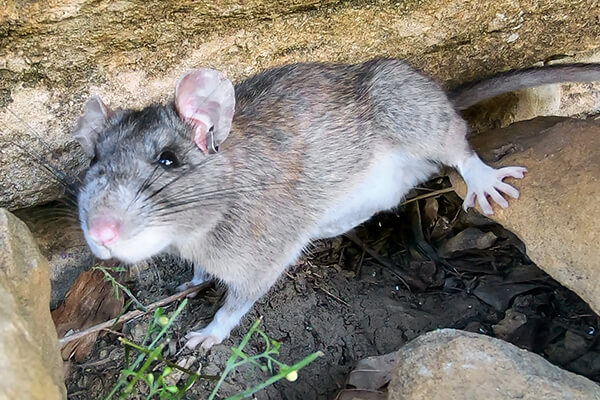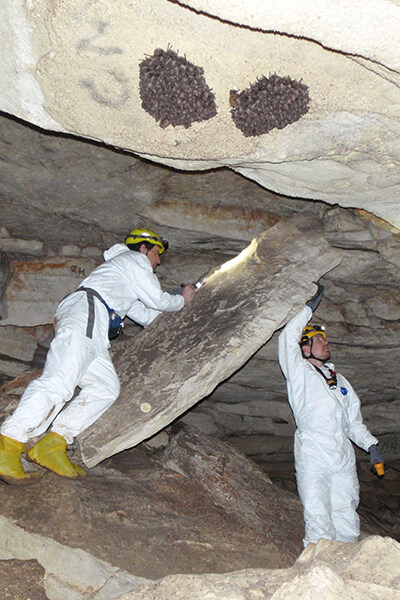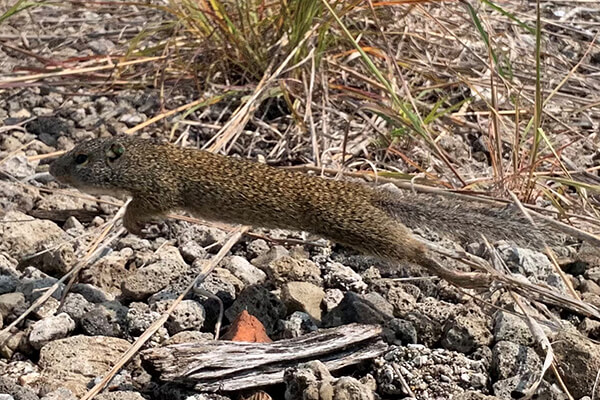Select image to enlarge and view caption.
Mammals
Indiana’s 60 species of mammals occupy diverse habitats in the state including forests, prairies, caves, cliffs, dunes, wetlands, lakes, and rivers. Some species may be seen near developed areas such as cities, suburbia, and agricultural lands. Many, however, may go unnoticed because of their nocturnal and secretive lifestyles, particularly flying squirrels, armadillos, and Indiana’s 13 species of bats. Others, such as the Allegheny woodrat and Franklin’s ground squirrel, occupy unique or rare habitats, making them difficult for most Hoosiers to see. In contrast, some other interesting species such as the star-nosed mole and thirteen-lined ground squirrel may be found in parks or backyards.
Habitat management and conservation programs for these species are supported through the generosity of Hoosiers who donate to the Indiana Nongame Wildlife Fund. No state tax dollars are used to manage these species. Consider donating today.
Of Indiana’s 60 mammal species, 22 are listed as a Species of Greatest Conservation Need (SGCN) by the Indiana DNR.
Check out the list of Indiana’s mammals below and explore the links on this page to learn more about Indiana’s unique, rare, and exciting mammals.
Monitoring Mammal Populations
Indiana DNR mammalogists conduct monitoring and research to better understand the status and distribution of the state’s mammals and to inform management activities. Several species have been monitored since the early 1980s, providing valuable long-term information.
- Winter Bat Counts
Winter surveys of hibernating bats have been an important part of this program for nearly 40 years. This long-term information has enabled the Indiana DNR to employ management strategies benefiting winter bat populations. Notable increases in the number of hibernating bats occurred in the mid-1980s and 1990s after cave tours were discontinued and bat-friendly gates were installed at cave entrances to prevent unlawful access. Populations declined sharply after the detection of white-nose syndrome (WNS) in 2011, but they appear to have begun the long road to recovery.
These winter surveys occur every other year to reduce disturbance of hibernating bats. The 2024 winter surveys found some exciting results. Indiana bat numbers increased overall. There were small changes in numbers of Indiana bats among caves, but the grand total nearly reached pre-WNS numbers. That’s not all. Numbers of tricolored bats and little brown bats, two of the species hit hardest by WNS, continue to slowly increase. These two species were also documented as having returned to caves they used to inhabit prior to WNS in Indiana.
These results are promising, but the conservation battle is far from over. Bats reproduce very slowly. Depending on the species, females can produce 1-3 pups per year, and some of those will not survive. The work that partners have invested in to help bats recover from WNS is paying off. These recovery tools include reducing disturbance during winter, protecting forested habitat near caves and summer roosts, removing invasive plants, and more.
- Acoustic Monitoring of Summer Bat Populations
Summer acoustic bat surveys have been conducted in Indiana since 2011. These surveys have helped biologists monitor trends in bat populations, including declines in hibernating populations due to white-nose syndrome (WNS). Beginning in 2020, survey methods were updated to match new standards introduced by the North American Bat Monitoring Program (NABat). Summer acoustic survey data are now shared with researchers across the continent to better understand conservation needs for all of North America’s bat species across their entire ranges.
Recent survey years have documented a shift in bat population trends after the worst impacts from white-nose syndrome passed. Hibernating populations have begun to stabilize, migratory species are declining due to fatalities at wind farms, and gray bats have become more common throughout southern Indiana. The ability to document these changes allows biologists to make the best decisions to help protect all of Indiana’s bat species at both the biological and policy levels.
Take a closer look at data from summer acoustic bat surveys and learn more about the acoustic monitoring of bats.
- Summer Bat Roosts
Bats use many different structures for roosting during summer months. These structures can include trees, barns, bat houses, attics, and basements, with females often forming larger clusters called maternity colonies where they raise young together. Monitoring these bat roosts provides an easy way to track trends in reproduction and relative abundance.
Residents who have a bat roost on their property are encouraged to join the program as a volunteer. Participants count the number of bats exiting the roost for a minimum of eight evenings during an eight-week summer surveying window. Additional data, including the type of roost structure and weather conditions, are also recorded. This can also provide a fantastic educational opportunity for families or small groups of children or adults who can monitor the bats together.
- Allegheny Woodrat
Once a widespread species across the southern half of the state, the Allegheny woodrat is now mainly found in the limestone and sandstone cliffs that border the Ohio River in Harrison and Crawford counties. Causes of the declines are multi-faceted and include habitat fragmentation leading to genetic isolation, increased predation, changes in forest composition, and mortality due to the parasitic raccoon roundworm. To remedy the causes of mortality, Indiana DNR has moved woodrats from nearby populations to improve genetic diversity and treats local raccoon populations for roundworm infection.
Biologists from across the species’ range are working to save the Allegheny woodrat. Various strategies are being implemented by each state, where appropriate, including improving raccoon roundworm treatments, captive breeding, adding artificial habitat, and providing acorns as a supplemental food source.
Biologists from across the species’ range are working to save the Allegheny woodrat. Various strategies are being implemented by each state, including improving raccoon roundworm treatments, adding artificial habitat, and providing acorns as a supplemental food source. Many states have identified low genetic diversity as an issue in their local woodrat populations. To remedy that, they are working with zoos to start captive breeding programs. In 2024, Indiana DNR contributed a female woodrat to a captive breeding program in which she will help produce young woodrats with strong genetics. Those young Allegheny woodrats will then be sent out to other states to help bolster existing woodrat populations and help establish new ones. As part of this interstate collaboration, Indiana received four young woodrats to augment Indiana’s populations. These individuals were fitted with VHF radio collars and released in areas where they could easily find food and mates. Continued participation in both programs will help benefit this species across much of its natural range.
- Franklin’s Ground Squirrel
This species of ground squirrel reaches the eastern extent of its North American distribution in northwest Indiana. However, loss of native prairies and other grassland habitats in this region has greatly impacted this species. By the 1990s, Franklin’s ground squirrels occurred only in nine Indiana counties, a decrease from the 17 counties they once occupied (Johnson and Chroromanski-Norris 1992).
Areas where the Franklin’s ground squirrel still thrives include prairies, fencerows, and rights-of-ways (ROWs) along highways or railroads. ROWs are often managed to limit growth of woody vegetation, which results in the grassy cover favored by the Franklin’s ground squirrel. Current monitoring efforts use trail cameras to identify habitats occupied by the species and live-capture surveys to estimate population size, mortality, and survivorship.
In 2024, DNR mammalogists began working with researchers at Purdue Fort Wayne to move a small number of Franklin’s ground squirrels from South Dakota to Indiana. This small population was slowly introduced into habitat in northwest Indiana on property owned and managed as a prairie by The Nature Conservancy. Many of the Franklin’s ground squirrels quickly adapted to Indiana, and this population will continue to be studied.
- Track & Sign Surveys
Indiana DNR mammalogists use modern techniques to survey for rare mammal populations, but technology has its limitations. By also training in track and sign interpretation, our mammalogists can better interpret wildlife sign and the behaviors of mammals in the field. These observations can lead to more efficient surveys and a better understanding of how these animals use their environment.
Tracking, and the ability to interpret wildlife sign, is free to everyone. All that is needed is curiosity and the ability to go to your backyard, local park, or a public land to start looking for tracks, scat, and other sign left by wildlife.
- Plains Pocket Gopher
The plains pocket gopher (Geomys bursarius) was listed as a species of special concern in Indiana in 2009 due to its limited and patchy distribution within the state. Plains pocket gophers prefer sandy or loose soils where they can efficiently tunnel, creating characteristic mounds that serve as key indicators of their presence. Because plains pocket gophers spend most of their lives underground and are rarely seen above the surface, biologists monitor their distribution primarily by surveying and counting these mounds. This method provides an effective, non-invasive way to track population trends and habitat use, helping guide conservation efforts for this species.
In 2024, DNR mammalogists conducted visual surveys along 3,295 miles of roads over 15 days, finding 3,473 gopher mounds in northwest Indiana. Most mounds (77.5%) were near good habitat, but available habitat has shrunk by 16.8% since 2001. Compared to past surveys, gopher distribution has also decreased, with fewer mounds found in White and Benton counties, where the species had historically occurred. Overall, these surveys indicate that the species is facing pressures that smaller, isolated populations can’t survive. One very easy way to reverse this species’ decline is teaching communities the benefits of gophers to soil health and how that impacts agriculture and human health. Further monitoring will give important new information to help with future research and conservation of plains pocket gophers.




